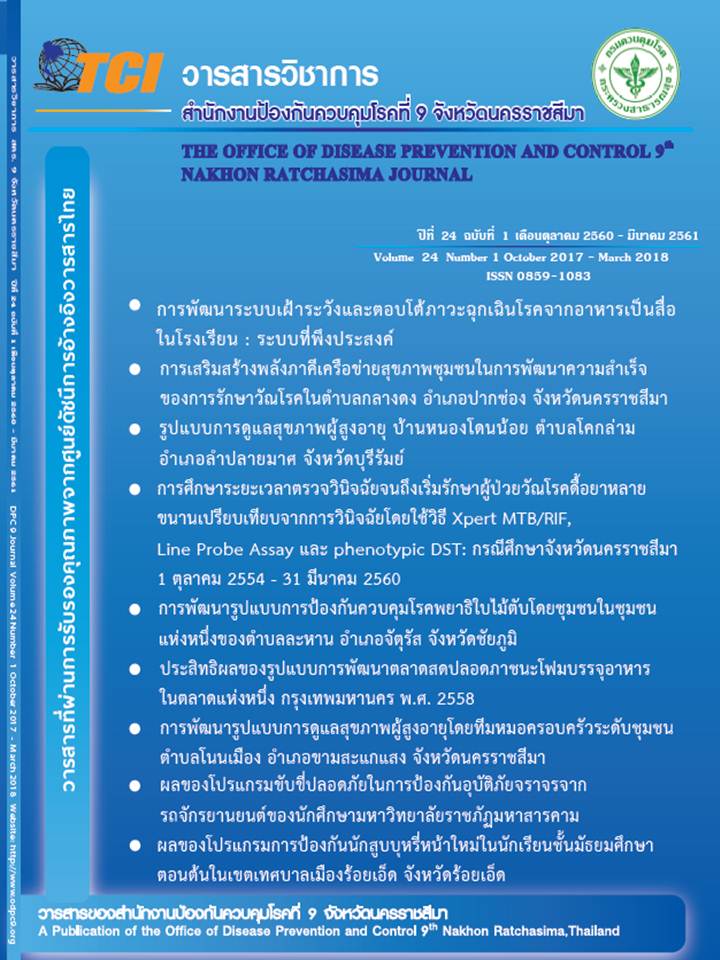Empowering the Community Health Network for the Successful Development of Tuberculosis Treatment in Klang Dong Sub-district, Pak Chong District, Nakhon Ratchasima Province
Keywords:
Tuberculosis, Empowerment, Participation for Collaboration NetworkAbstract
The objective of this action research was to investigate into an empowerment process of the The objective of this action research was to investigate into an empowerment process of the community health collaboration network for the successful development of Tuberculosis treatment in areas of Klang Dong Sub-district, Pak Chong District, Nakhon Ratchasima Province. The target groups included 48 people from community leaders, health offif icials at Tambon health promoting hospitals, offif icials at the Public Health and Municipal Environment Division, TB patients and their relatives. Data was quantitatively and qualitatively collected through interviews, meeting notes, focus group interviews, observations and interviews. Data analysis was carried out by using descriptive statistics such as frequency, percentage, average, and standard deviation. The paired sample t-test was used as test statistics with content analysis for qualitative data. The results showed that the empowerment comprised statistics with content analysis for qualitative data. The results showed that the empowerment comprised eight stages as follows 1) Opportunity to def ifine development plan for related people 2) Participants are excited to do activities 3) Participants like to participate every parts of activities 4) Patient, relative patient and participants have more knowledge and are excited to do work 5) Make good relationship to each other and have responsibilities together 6) Collaboration 7) Encouragement from all related departments and 8) Integration to do work together for all departments. The study indicated that changes in knowledge, participation and satisfaction of stakeholders after implementation were greater with statistical signifif icant level of p-value < 0.05 and with greater cooperation in the areas resulting in a successful rate of 100 percent tuberculosis treatment.
References
2. World Health Organization (WHO), Global Report on TB. s.l: World Health Organization, 2011.
3. กรมควบคมุโรค กระทรวงสาธารณสขุ. รายงานสถานการณว์ณัโรค. กรงุเทพฯ: กระทรวงสาธารณสขุ, 2553.
4. สำานักงานสาธารณสุขจังหวัดนครราชสีมา. รายงานการเฝ้าระวังทางระบาดวิทยา. นครราชสีมา: สำานักงาน สาธารณสุขจังหวัดนครราชสีมา, 2557.
5. สำานักงานสาธารณสุขอำาเภอปากช่อง. รายงานการเฝ้าระวังทางระบาดวิทยา. นครราชสีมา: สำานักงาน สาธารณสุขอำาเภอปากช่อง, 2557.
6. โรงพยาบาลสง่เสรมิสขุภาพตำาบลกลางดง. รายงานการเฝา้ระวงัทางระบาดวทิยา. นครราชสมีา: โรงพยาบาล ส่งเสริมสุขภาพตำาบลกลางดง, 2557.
7. กลุ่มวัณโรคสำานักโรคเอดส์วัณโรคและโรคติดต่อทางเพศสัมพันธ์ กรมควบคุมโรค กระทรวงสาธารณสุข.
แนวทางการดำาเนินงานตามแผนงานวัณโรคแห่งชาติ. กรุงเทพฯ: กรมควบคุมโรคกระทรวงสาธารณสุข,
2548.
8. ปรียา สินธุระวิทย์ และวันเพ็ญ ปัณราช. การพัฒนาแนวทางการควบคุมวัณโรคในชุมชนของโรงพยาบาล วานรนิวาส จังหวัดสกลนคร. สกลนคร: สำานักงานสาธารณสุขจังหวัดสกลนคร, 2555.
9. Gibson,C.H. A Study of Empowerment in Mothers of Chronically ill Children. Michigan: Boston
College, 1993.
10. ภสัสรุยี์ คณูกลาง. ปจัจยัทมี่คีวามสมัพนัธก์บัการมสีว่นรว่มของคณะกรรมการชมุชนในการพฒันาเมอืงนา่อยู่ อยา่งยงั่ยนื เทศบาลนครขอนแกน่ จงัหวดัขอนแกน่. วทิยานพินธป์รญิญาสาธารณสขุศาสตรมหาบณัฑติ
สาขาวิชาการบริหารสาธารณสุข มหาวิทยาลัยขอนแก่น, 2546.

Published
How to Cite
Issue
Section
License
บทความที่ลงพิมพ์ในวารสารวิชาการสำนักงานป้องกันควบคุมโรคที่ 9 จังหวัดนครราชสีมา ถือว่าเป็น
ลิขสิทธิ์ สำนักงานป้องกันควบคุมโรคที่ 9 จังหวัดนครราชสีมา



